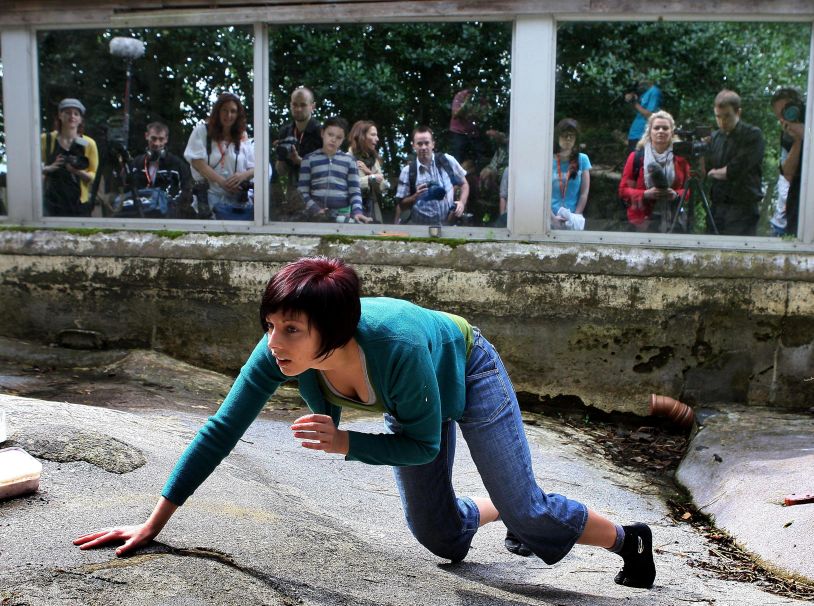Edinburgh 2008: Dancing, eating, feeding, fighting... welcome to the human zoo

Your support helps us to tell the story
From reproductive rights to climate change to Big Tech, The Independent is on the ground when the story is developing. Whether it's investigating the financials of Elon Musk's pro-Trump PAC or producing our latest documentary, 'The A Word', which shines a light on the American women fighting for reproductive rights, we know how important it is to parse out the facts from the messaging.
At such a critical moment in US history, we need reporters on the ground. Your donation allows us to keep sending journalists to speak to both sides of the story.
The Independent is trusted by Americans across the entire political spectrum. And unlike many other quality news outlets, we choose not to lock Americans out of our reporting and analysis with paywalls. We believe quality journalism should be available to everyone, paid for by those who can afford it.
Your support makes all the difference.People have performed in a public lavatory, a tree, and a car, but now an Edinburgh Fringe group has been put where some might say they all belong: in the zoo.
Exploring human nature through dance, movement, and being locked up for seven hours at a time, a group of female dancers will be the latest exhibit at Edinburgh Zoo, Enclosure 44 – Humans. Categorised by the show's creators as an endangered species, the group of professional dancers will be occupying a cage that formerly housed beavers, where they eat, fight, get changed, or just sit and stare.
Janis Claxton, the artistic director, said the largely improvised show was more than a gimmick. "I have been working for a year and a half observing animal and human behaviour in zoos around the world. Humans are one of the great apes," she said. "Here, we take away inventions, including speech, and so our mode of expression is our bodies and our states of mind are abstracted into movement.
"It feels like there is no barrier between performers and the audience. You can see every facial expression coming back at you and people are more open, more observational and less judgemental. They look at us like tigers."
Audience and performers gain a sense of what it means to be imprisoned, added Claxton, an Australian dancer and choreographer. "We've only done a whole day once before and it can get frustrating, but because of the environment we access this emotional range without trying: frustration, being cold and wet, as well as feeling fantastic."
Four performers, dressed in casual clothes and two-toed slippers, are in the zoo from 10am until 5pm until 16 August. They have labels explaining their food preferences and origin – Terra Australis, Anglia and Caledonia – and will be joined by Kirki Kyrkou from Graecia next week. Breakfast is at 10am, lunch at 1pm, and the human animals go into various set-piece dance games throughout the day. Visitors are invited to listen to a talk by their resident keeper, Angus Balbernie, an actor, at 3pm. Balbernie, in zookeeper uniform, was anxious about their media debut. "This is their first interaction, it could get explosive," he warned. "One of their sharp ronde de jambe [dance moves] can rip the lens off a camera."
He said the species merited study. "Human DNA is only 2 per cent removed from the higher ape and this particular species, the dancer, is disappearing off the planet due to a problem called arts funding. I have studied lions and they do not have a problem living in harmony with the planet, but the interaction of humans is highly questionable."
At the first public performance yesterday, reactions were strong. One mother pulled away her children, muttering: "It's too weird." But two other children, Anna and Kirstin Aikman, were fascinated. "Why are they having breakfast in the enclosure in their pyjamas, and how do they get out?" Kirstin wanted to know.
Morag Deyes, artistic director of Dancebase, Scotland's National Centre for Dance, said: "It is a genius idea. It says something profound about the human condition, questioning whether we are really that different from animals."
Other unusual Fringe venues include an urban gap site where skateboarders, BMX bikers, free runners and breakdancers perform Transgression, and a cellar which serves as a theatre for The Factory, conveying the feeling of a Nazi gas chamber.
Join our commenting forum
Join thought-provoking conversations, follow other Independent readers and see their replies
Comments